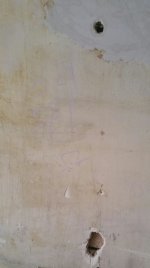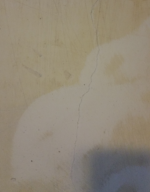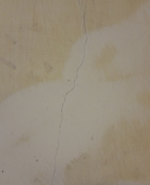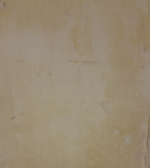TLDR: I need to sand concrete, stone, granite (Actually 1.3 century old Burnished Lime Plaster) with dust extraction and I can't find an abrasive that will chew the surface. Mirka Ceros 6" or ROTEX90, or Bosch 5" RO?
Abrasives for Lime Putty finished, smooth rendered walls to open pores for limewash, and venetian plaster?
Okay, I've lurked here for 6 months, a lot of good information. Thank you for that. I'm now at a bit of a bind-
Not just a homeowner, I put in 20 years honing trades working with my father before I became a physicist.
I have an 1885 Victorian, with that is my biggest project to date- to restore our home against 70years of unskilled 'craftsmen' while keeping my family and I relatively safe from hazardous materials. Festool and others have been a welcomed addition to this end.
However, I've been able to remove the designer's paper beneath layers of paint and horrible "skim coats" of gypsum joint compound down to the finished lime plaster. I've slaked my own high calcium Quicklime to lime putty and aged for over a year so far. The walls are remarkably smooth save some natural hairline shrinkage cracks, and a handful of walls with serious settling cracks. These will have to be addressed with lime and mesh once I finish jacking the house and repairing the Main girt and center supports.
In the meanwhile, I want to finish the walls with pigmented Lime Wash. They are mostly glass smooth, I've removed what glue sizing I could. It is a smooth, burnished surface. Not a lot of mechanical grip for lime. Now I would go across with a devils float, or/and two other methods I've thought up:
shallow 5mm cuts with a ts75, guide rail in a grid array. 15, 10, and 20 mm whole saws run 2-5mm into the surface in a scatter shot pattern to create teeth for a positive mechanical lock, were I ready to mesh and re render a brown and finish coat- but as I'll be moving the load distribution: I'm not there yet.
I want to limewash, and in some small rooms, fairly isolated from the center girt beam- where the walls are pristine: trowel on smooth, pigmented glossy venetian marble lime plaster. If I was not able to get down to the beautiful fished lime rendering, or didn't know about building science: I'd use a quartz primer.
But I don't want to change the vapor handling of of most walls, i.e. forfeit or in the case of quartz primer: retard the hygroscopic nature of the lime render from one side (or any).
SO: I need to sand the surface, and remove the burnish, and any glue sizing, beer or soap or oil etc. that may have been used to seal the finished lime rendered surface, so that I can achieve a sufficient maximum of mechanical and chemical bonding affinity for the lime wash or finish plaster. To open up the pores of the burnished lime plaster.
I need either
1.Diamond
2.Silicone Carbide
3. MAYBE...a really good aluminum oxide
4.?
I need it to fit a Mirka Ceros 6" or Festool ROTEX90 or a Bosch 5" RO so I can use dust extraction.
The problem is, festool only has Saphir which is Silicone Carbide and Aluminum oxide, and *could* do concrete- But they only make it for Delta pads and other sanders like the planex from what I can tell. Abranet, Abranet HD, and Abranet ACE don't cut it, Neither does GRANAT.
I will eventually get a Planex, but the Domino XL, TS75, LS130, CT36E, CT36AC, CTMIDI, ROTEX90, CEROS 5mm6", OF1400, Guide Rails, Miller Dynasty 280DX, torches, TIG cooler, Fluke DMM, Paint Shaver Pro, and all the other tools and consumables of a year long spending rampage has me putting that off for a year...
Kinda feel that for what I've spent on premium tools- I should be able to find *something* in the way of abrasives for the $1,000 on the mirka and Festool to leave the angle grinders as primitive solutions, and keep the 2k in Festool Dust extractors: Relevant.
How would you abrade these walls to prep for finish? ....without throwing more money at Festool. [wink] Starting to think my only solution is to buy a 4" diamond disc, or a pack of planex or ras saphir and recut the dimension and cut out the holes for the ROTEX and CEROS.
*EDIT: Attached Picture. Pictured: Lime Plaster wall for referencing the the color and finish and some egregious gypsum skim coat during the removal of paint, paper and patch work.
Abrasives for Lime Putty finished, smooth rendered walls to open pores for limewash, and venetian plaster?
Okay, I've lurked here for 6 months, a lot of good information. Thank you for that. I'm now at a bit of a bind-
Not just a homeowner, I put in 20 years honing trades working with my father before I became a physicist.
I have an 1885 Victorian, with that is my biggest project to date- to restore our home against 70years of unskilled 'craftsmen' while keeping my family and I relatively safe from hazardous materials. Festool and others have been a welcomed addition to this end.
However, I've been able to remove the designer's paper beneath layers of paint and horrible "skim coats" of gypsum joint compound down to the finished lime plaster. I've slaked my own high calcium Quicklime to lime putty and aged for over a year so far. The walls are remarkably smooth save some natural hairline shrinkage cracks, and a handful of walls with serious settling cracks. These will have to be addressed with lime and mesh once I finish jacking the house and repairing the Main girt and center supports.
In the meanwhile, I want to finish the walls with pigmented Lime Wash. They are mostly glass smooth, I've removed what glue sizing I could. It is a smooth, burnished surface. Not a lot of mechanical grip for lime. Now I would go across with a devils float, or/and two other methods I've thought up:
shallow 5mm cuts with a ts75, guide rail in a grid array. 15, 10, and 20 mm whole saws run 2-5mm into the surface in a scatter shot pattern to create teeth for a positive mechanical lock, were I ready to mesh and re render a brown and finish coat- but as I'll be moving the load distribution: I'm not there yet.
I want to limewash, and in some small rooms, fairly isolated from the center girt beam- where the walls are pristine: trowel on smooth, pigmented glossy venetian marble lime plaster. If I was not able to get down to the beautiful fished lime rendering, or didn't know about building science: I'd use a quartz primer.
But I don't want to change the vapor handling of of most walls, i.e. forfeit or in the case of quartz primer: retard the hygroscopic nature of the lime render from one side (or any).
SO: I need to sand the surface, and remove the burnish, and any glue sizing, beer or soap or oil etc. that may have been used to seal the finished lime rendered surface, so that I can achieve a sufficient maximum of mechanical and chemical bonding affinity for the lime wash or finish plaster. To open up the pores of the burnished lime plaster.
I need either
1.Diamond
2.Silicone Carbide
3. MAYBE...a really good aluminum oxide
4.?
I need it to fit a Mirka Ceros 6" or Festool ROTEX90 or a Bosch 5" RO so I can use dust extraction.
The problem is, festool only has Saphir which is Silicone Carbide and Aluminum oxide, and *could* do concrete- But they only make it for Delta pads and other sanders like the planex from what I can tell. Abranet, Abranet HD, and Abranet ACE don't cut it, Neither does GRANAT.
I will eventually get a Planex, but the Domino XL, TS75, LS130, CT36E, CT36AC, CTMIDI, ROTEX90, CEROS 5mm6", OF1400, Guide Rails, Miller Dynasty 280DX, torches, TIG cooler, Fluke DMM, Paint Shaver Pro, and all the other tools and consumables of a year long spending rampage has me putting that off for a year...
Kinda feel that for what I've spent on premium tools- I should be able to find *something* in the way of abrasives for the $1,000 on the mirka and Festool to leave the angle grinders as primitive solutions, and keep the 2k in Festool Dust extractors: Relevant.
How would you abrade these walls to prep for finish? ....without throwing more money at Festool. [wink] Starting to think my only solution is to buy a 4" diamond disc, or a pack of planex or ras saphir and recut the dimension and cut out the holes for the ROTEX and CEROS.
*EDIT: Attached Picture. Pictured: Lime Plaster wall for referencing the the color and finish and some egregious gypsum skim coat during the removal of paint, paper and patch work.




